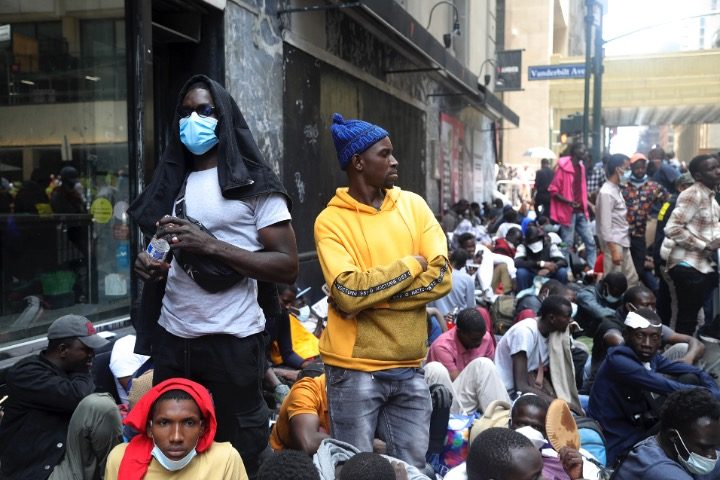
New York City’s Democratic Mayor, Eric Adams, is not holding back in putting blame on the Biden administration for unfavorable images coming out of the City That Never Sleeps, where adult migrant men sleeping on the streets of Manhattan have become a fixture among the migrant crisis precipitated by the White House’s open migration policy.
“We need help,” Adams said on Monday, as Politico reported. “And it’s not going to get any better. From this moment on, it’s downhill.”
As seen in videos and photographs making their way through the internet, some of the newly arrived foreign men have taken to sleeping on cardboard boxes, as the city says it has reached its capacity for housing migrants.
“No one wants anyone sleeping on the street or being used as a pawn in a political fight, but it’s just plain reality that there’s no more room,” a city hall official said to Politico. “And week after week, the pressure is going to keep mounting on Washington to do something now or wait for it to impact the 2024 elections.”
Over 93,000 new migrants have set foot in New York City since last spring — and more than half of these are still under the city’s care. Adams lays the blame on the administration for failing to provide New York with sufficient money, and for dragging its feet on work authorization for the migrants.
Meanwhile, the White House has passed the buck to Congress, saying that the Legislature, not the presidency, must come up with a solution.
Of course, it is the White House whose actions led to this dilemma. The lax immigration enforcement and scrapping of Trump-era migration restrictions — such as Trump’s use of Title 42 to immediately expel illegal aliens who crossed the border amid Covid-19 — has led to a migrant surge at the border that has rolled over into a crisis in American communities, especially in New York.
Politico reported of the back-and-forth between Adams and federal policymakers:
“There were bordering states that received more money than us, and they’re using the money to bus people to New York,” Adams said Monday at an unrelated news conference. He said New York City has received only $30 million in federal aid thus far for a crisis he estimated would cost $4.2 billion by next summer.
New York congressional leaders also announced in June that New York City was allocated nearly $105 million in FEMA funds for the migrant crisis. Adams said the city has yet to receive that money.
Mayoral spokesman Fabien Levy told Politico that families and children are prioritized and placed in shelter every night. But the city’s capacities do not currently allow for the housing of all the military-age men spilling out onto New York’s streets.
“We continue to do our best to at least offer adults a temporary place to wait off the sidewalks,” Levy said. “But, in all honesty, New Yorkers may continue to see more and more migrants waiting outside as hundreds of asylum seekers continue to arrive in our city seeking shelter every day.”
The New American previously reported that the number of asylum-seeking migrants being taken care of by the city has surpassed the number of homeless New York residents under municipal care.
To meet the huge demand, the city has created 12 Humanitarian Emergency Response and Relief Centers and 176 shelter sites. An extension of contracts for 10 navigation sites (and the opening of an 11th) alone will be costing New Yorkers an additional $2.3 million.
The crisis has put Adams and other elected officials in a bind. To deal with the flood of migrants, Adams has enacted a program of transporting migrants out of the city to other counties, other states, and even other countries — though he has criticized Republican-led states such as Texas and Florida for doing the same thing.
New York City spent approximately $50,000 between April 2022 and April 2023 for the resettlement of 114 migrant families.
The top destination for these relocations was Florida, which took 28 families. Texas, with 14 families, came in second place. In third place was North Carolina, which received six families. In total, New York City’s Department of Social Services assisted with travel to 64 cities in 27 states.
Adams’ administration even purchased migrants plane tickets to foreign nations such as Colombia, China, Peru, Ecuador, and Venezuela.
Adams has floated the idea of paying homeowners and landlords to house migrants in spare rooms.
Camille Rivera, a Democratic consultant, is one of many in her party pushing for private businesses and homeowners to take in migrants with the assistance of the state government.
“There are spaces and there are opportunities to make space for people,” Rivera told Politico. “This is an operational juggernaut and intake is hard, but this is New York City, and you do what you need to do to make sure people are taken care of.”
How well such policies would be received is uncertain. Would citizens support assuming the migrant load from the shoulders of the government when it was politicians that caused the crisis in the first place?
To learn more about the immigration crisis and what can be done about it, click here.




